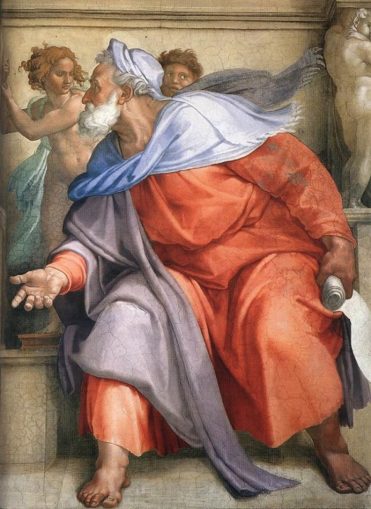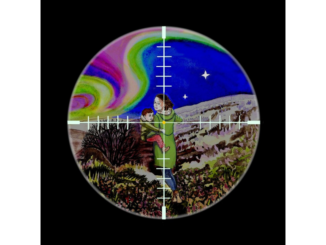
By Michelangelo Buonarroti – http://www.zeno.org/Kunstwerke.images/I/77j309a.jpg, Public Domain, Link
I wrote these articles at the prompting of Goodnight Vienna who became very interested in the Old Testament prophets at the end of her life, and the pair on Ezekiel were the last ones she read. It’s with bitter regret I didn’t finish the series in time for her, particularly Daniel whom she particularly requested. I was saving Daniel to last as his prophecies are in some ways the most difficult, complex and profound for us as well as those of his own time. To be honest, I’m a bit intimidated by Daniel because much of what he writes appears to fit our times and his saliency makes him controversial and difficult, but I will get on to him shortly. I owe GV that.
In Part One I recounted what we know of the prophet Ezekiel, his life and times, and the main themes of his oracles and their relevance for us today. In some ways I was perhaps a little hard on him, characterising him as more narrowly focused on Jewish preoccupations, and therefore lesser than prophets such as Isaiah with their broader and longer perspectives. We can in part understand that because he was one of the first wave of Jewish prisoners taken by to Babylonia and was focused on helping the Jewish people retain their unique faith and culture when exiled to a foreign land. That said, he was innovative in for the first time in many centuries as seeing all followers of Jehovah, including the remnants of the Ten Tribes of Israel deported a century earlier to the same region by the Assyrians, as one people united under Jehovah.
His book was centred around six visions in three pairs, but of these six two are perhaps the most arresting and famous:
- the first, of God and His throne surrounded by extraordinary creatures and sights, and
- the second, of the Valley of Dry Bones, to which Ezekiel is taken by God.
Of these two, the second has entered modern idiom, appearing as a metaphor of many songs and works of literature. It’s a very powerful image indeed – a broilingly hot and dry hill valley, dusty and shadeless, covered by large numbers of dry bones, bones with no flesh or sinew, just scattered and abandoned – a bleak lifeless scene, a scene of hopeless desolation and death. Ezekiel begins his account with these words: “The hand of the Lord was upon me, and carried me out in the spirit of the Lord, and set me down in the midst of the valley which was full of bones” (Ezekiel 37:1).
The imagery of a scene far more common in Ezekiel’s homeland of the Judean highlands, perhaps even the Jordan Valley near the Dead Sea, a valley more than 1,300 feet below sea level, than in the lusher irrigated plains of Mesopotamia. Perhaps Ezekiel was taken in vision down to this very low and very hot area, where Sodom and Gomorrah used to be. Hot, arid scrub desert, even the water too saline to drink.
Everywhere, on every side, were dead men’s bleached bones – Ezekiel was surrounded by a countless number of bleached bones from this slain multitude. When an army was defeated in battle in Biblical times, the victorious soldiers would often strip the valuables from the slain and then leave their enemies’ bodies unburied. In remote places where there had been serious battles, skeletons sometimes remained for many years afterwards, until the beasts of carrion completely scattered the bones or they surrendered to the elements. This image of a valley covered with bones was not merely an abstract concept, Ezekiel lived at a time when one could find literal valleys of bones, places where the slain enemy had been overwhelmed and there was no one to bury them. In the Bible, a corpse not properly buried was considered to be accursed by God.
This passage of Ezekiel stresses the dryness of the bones (verse 2). In a part of the world where water was a scarce resource, dryness was associated with death, and deserts were places of little life where demons lurked, and dry bones were bones with no possibility of life, even for carrion, and with death with no possibility of revival. It was one reason why the Egyptian Desert Fathers, the first hermit movement which led to the monastic movement, was so impressive to early Christians. The Desert Fathers sought out these arid places on the edge of deserts for their lives of prayer and seclusion, demonstrating their strength of faith and Holiness, metaphorically building spiritual defences against the dark and deathly forces of the desert beyond.
The key passage of the chapter is worth relaying in full, not only for the wonderful figurative descriptions of the reanimation of the bones.
‘Then He said to me, “Prophesy to these bones, and say to them: O dry bones, hear the word of the Lord. Thus says the Lord God to these bones: I will cause breath to enter you, and you shall live. I will lay sinews on you, and will cause flesh to come upon you, and cover you with skin, and put breath in you, and you shall live; and you shall know that I am the Lord.” So I prophesied as I had been commanded; and as I prophesied, suddenly there was a noise, a rattling, and the bones came together, bone to its bone. I looked, and there were sinews on them, and flesh had come upon them, and skin had covered them; but there was no breath in them. Then He said to me, “Prophesy to the breath, prophesy, mortal, and say to the breath: Thus says the Lord God: Come from the four winds, O breath, and breathe upon these slain, that they may live.” I prophesied as he commanded me, and the breath came into them, and they lived, and stood on their feet, a vast multitude. Then He said to me, “Mortal, these bones are the whole house of Israel. They say, ‘Our bones are dried up, and our hope is lost; we are cut off completely.’ Therefore prophesy, and say to them, Thus says the Lord God: I am going to open your graves, and bring you up from your graves, O my people; and I will bring you back to the land of Israel. And you shall know that I am the Lord, when I open your graves, and bring you up from your graves, O my people. I will put my spirit within you, and you shall live, and I will place you on your own soil; then you shall know that I, the Lord, have spoken and will act,” says the Lord.’
Bear in mind that this prophesy was made at least 2.5 decades before the unexpected liberation of the Jews from captivity in modern day Iraq by Cyrus the Great, and yet clearly forecasts their freedom and return to Israel, a preoccupation of Hebrew prophets even earlier than Ezekiel, but was made at the time of the very nadir in the fortunes of the Jews – the ‘dry bones scattered in the badlands’.
What is even more interesting is:
- 1The reference to the ‘whole house of Israel’, not just those taken captive from Judah but also a century or so earlier those taken by the Assyrians from the ten Tribes of Israel and settled in northern Iraq, presumably their descendants who had retained some vestige of their cultural identity. Ezekiel is here seeing a new Israel combined from the dead remains of the two kingdoms being restored by their common faith in Jehovah. [This puts the lie to some of the conspiracy theories that lie around on the subject of the ‘missing Ten Tribes of Israel’ and the likes of Ezekiel clearly saw at least some of them as returning as one restored people with the other two tribes.]
- The focus on the physical resurrection of the dead following the injection of God’s Spirit – in Christian terms the Holy Spirit – into their bodies, implying that they cannot sustain life without the presence of God within them. Inculcated as we are in Christian civilisation, we are not perhaps aware that this was not common thinking among the ancient Jews. Several sects, notably the Sadduccees, believed that the soul died with the body and that there was no afterlife, others effectively in reincarnation and others in an underworld – Sheol – not wildly dissimilar to the Hades of the Greeks.
Ezekiel was perhaps not treading entirely new ground in Hebrew theology here but was certainly not in the mainstream tradition. His emphasis of this point suggests he’s using it as more than symbolism but is, as we so often find in the Bible, using one description to make several points with different layers of meaning, one about national restoration, one about the instrumentality of the Jewish God in enabling that restoration, and one about the possibility of physical resurrection from the place of dead bones, i.e. the grave.
And this is where we get to his link to Christian thought and his profound influence on Christian prophetic thinking. Christ was of course executed in a place of death and dry bones – Golgotha or Place of the Skull’ – and His resurrection of course being the single central event of Christianity, which extended the possibility of the afterlife to all believers. It was never thought that the Jews returning from exile brought all the bones of those who had died there back with them, but it was a metaphor not only for the first restoration of Israel after the 550s BC, but for the future restoration as part of the End Times prophecies, and then the resurrection of the dead pending the Final Judgement.
Finally, it has become a metaphor among Christians, as to how a church or nation, which is spiritually dead and without hope, can be reanimated by true faith, that no situation is ever entirely hopeless and that with God all things are possible. How relevant such things are to us today and how empty of transform faith our institutionalised churches seem, having been subject to bureaucratic capture.
How much of this Ezekiel himself intended cannot be known, perhaps not much beyond the restoration of Israel which happened a generation after his lifetime, but he would be far from the first writer whose words have had a greater significance accorded them by others beyond his own original understanding.
© 1642again 2019
The Goodnight Vienna Audio file
Audio Player



